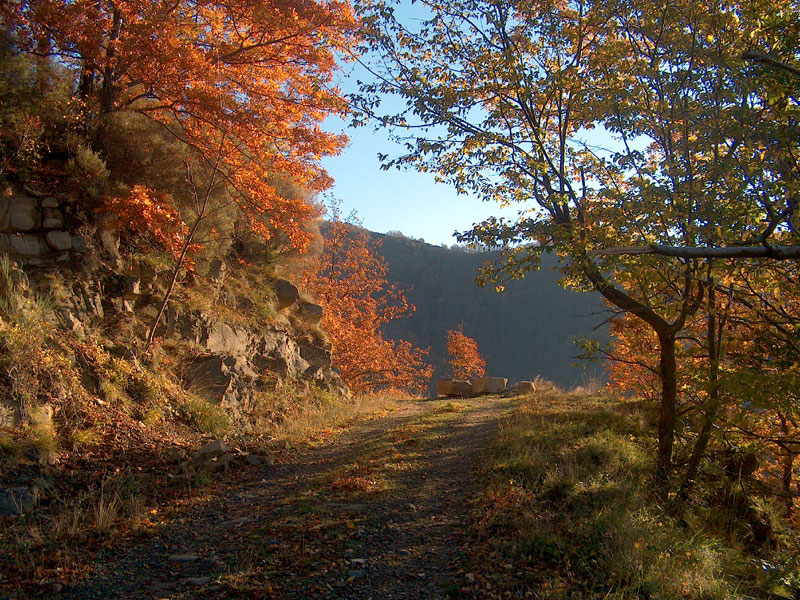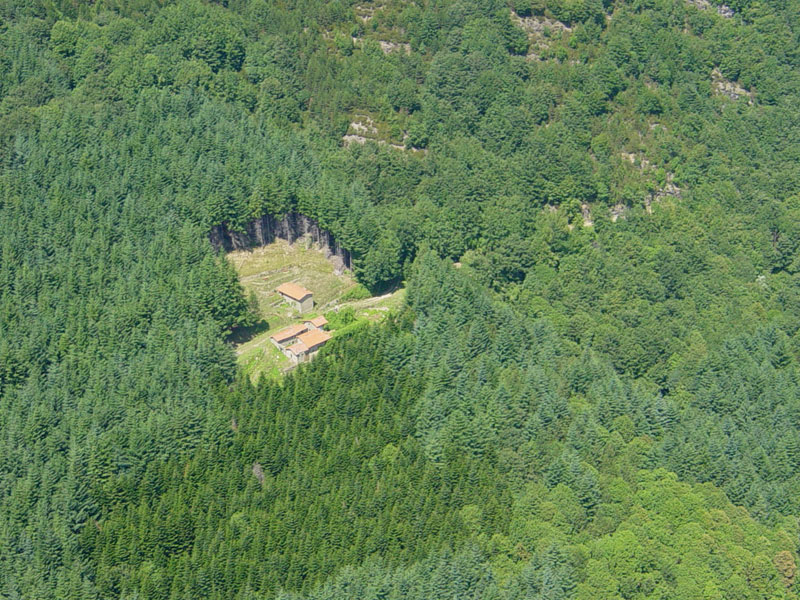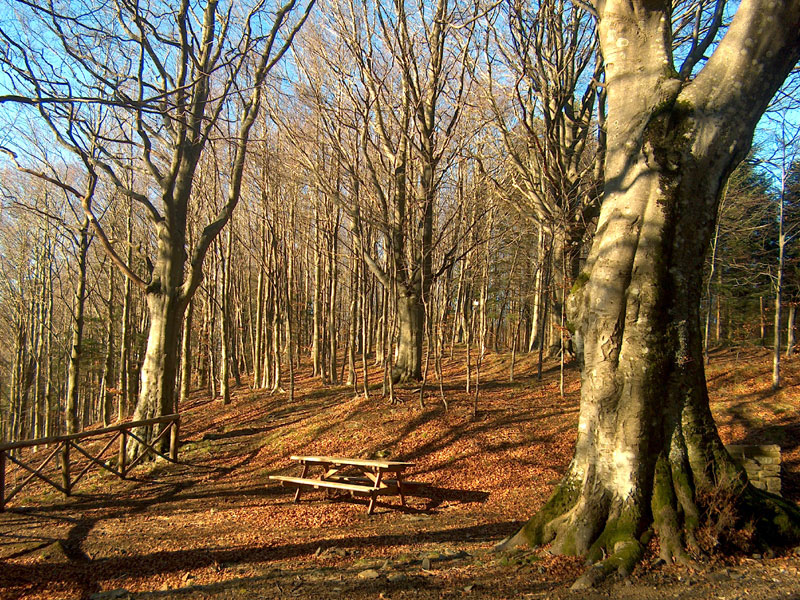Protected Area
Identity Card
- Land Surface Area: 929.00 ha
- Regions: Toscana
- Provinces: Firenze
- Municipalities: Reggello
- Establishment Measures: LR 49 11/04/1995 - DCC 171 22/12/1997 - DCC 46 29/3/99
- PA Official List: EUAP1000
- Park Authority: Comune di Reggello
![]() Regulations of A.N.P.I.L. Foresta di Sant'Antonio (PDF, Italian text - 145 Kb)
Regulations of A.N.P.I.L. Foresta di Sant'Antonio (PDF, Italian text - 145 Kb)
The Forest
The forest covers an area of about 900 hectares, between 600 and 1,490 m of altitude, in the mountains upriver from Reggello.
The most widespread plant species is the Beech, followed by the
Chestnut Tree, the Turkey Oak, and the Hornbeam. Some areas that have
been interested by reforestation activities house Douglas Firs, Silver
Firs, Spruce Firs, and Black Pines.
The Protected Area is very important for the variety of the botanical
species characterizing it and for the beauty of the mountain slopes
where these plants grow. Among the species of interest: Campanula persicifolia, Dianthus balbisii, the Martagon Lily and some orchids (Orchis maculata, Orchis mascula and Orchis sambucina).
Geographical Boundaries
S.Antonio Forest is surrounded by Pratomagno chain, a ridge developing
for about 40 km towards the Apennines, from Consuma Pass (Florence) to
the south of Talla (Arezzo), delimiting in the NE the Upper Valdarno
basin and in the SW the Casentino basin, running parallel to the chain.
It forms a semicircle developing along the highest bank of the stream
Resco, in the Municipality of Reggello. It is delimited in the north by
the ridge of Poggio Massa Nera (1,075m a.s.l.) which, in direction
north-east, joins the ridge of Pratomagno.
In its altitude limit,
the forest follows the main ridge crossing Poggio della Risala (1,485m
a.s.l.), Croce al Cardeto (1,356m a.s.l.), Poggio alla Cesta (1,446m
a.s.l.), Varco di Reggello (1,354m a.s.l.); then, in the south, it
separates and follows the secondary ridge of Poggio Castelluccio, at
the border with the Municipality of Castelfranco di Sopra (AR). Its
lower border has an irregular pattern, following ditches and ridges,
marked by Pian della Farnia and Case Lavane.
The rough landform is characterized by steep slopes, marked ridges,
rocky cliffs, and deep ravines coming together towards the stream
Resco, with the gullies of S.Antonio, Rota, and Stufa. The average
altimetry is between 950-1,000m a.s.l., with a minimum height of 600m
and a maximum height of 1,490m along the main ridge.
Vegetation
| After analyzing the vegetation map of
S.Antonio forest, it is clear that the beech wood dominates on the
coolest and highest slopes, reaching the cacuminal prairie. The beech
wood is dominated here by coppice formations followed by transition
high forests. At lower altitudes and on the warmest slopes, different broadleaf trees replace the Beech: among them, the Turkey Oak, the Hop Hornbeam, and the Chestnut Tree. They form pure woods or mixed woods of broadleaf trees, also characterized by the presence of Flowering Ash, Italian Maples, and White Hornbeams. On the most open and driest slopes the Downy Oak woods dominate. The southern exposures are characterized by thick shrub formations and heaps of stones covered with heath and broom, that is rocky gullies alternating with graminaceous prairies. These lands have been interested more than once by fires: the most serious in 1943 and 1946, when the 78% of the woodland state property was destroyed. These events led the forest administration to stop the woodland exploitation and to carry out reforestation activities in the areas of Massa Bernagia, Massa Nera, and Macinaia: the results are artificial pure or mixed woods dominated by Douglas Fir Tree, Silver Fir, Spruce Fire, Black Pine, and Beech. In the following table you will find the kinds of vegetation growing in Sant'Antonio Forest and their corresponding areas: |
||||||||||||||||||||||||||||||||||||||||||||
Vegetation in the Forest of Sant'Antonio, area in ha:
|
Fauna
Given the great variety of habitats characterizing it, S.Antonio Forest is populated by a varied and abundant fauna.
Among the ungulates, the Roe Deer (Capreolus capreolus), the Fallow Deer (Dama dama), and the Wild Boar (Sus scrofa). Of interest also the presence of "minor mammals" like the Brown Hare (Lepus europaeus), the Badger (Meles meles), the Dormouse (Glis glis), the Red Squirrel (Sciurus vulgaris), the Beech Marten (Martes foina), and the Fox (Vulpes vulpes). Among the birds, we mention only the most common ones, like the Coal Tit (Parus ater), the Whitethroat (Sylvia communis), the Redstart (Phoenicurus phoenicurus), the Nuthatch (Sitta europea), and the Dipper (Cinclus cinclus). Among the big-size birds, the Carrion Crow (Corvus corone), the Ring-necked Pheasant (Phasianus colchicus), the Cuckoo (Cuculus canorus), the Hoopoe (Upupa epops), the Jay (Garrulus glandarius). Among the birds of prey, the Kestrel (Falco tinnunculus), the Buzzard (Buteo buteo), the Sparrow Hawk (Accipiter nisus), the Barn Owl (Tyto alba), the Little Owl (Athene noctua), the Long-eared Owl (Asio otus), and the Tawny Owl (Strix aluco).
Among the amphibians, we can mention the Fire Salamander (Salamandra salamandra), the Yellow-bellied Toad (Bobina variegata pachypus), and the Common Toad. Among the reptiles, there are many species of Ophidia like the Grass Snake (Natrix natrix), the Aesculapian Snake (Elaphe longissima), the Whip Snake (Coluber viridiflavus), and the Viper (Vipera aspis). The entomofauna is very rich. The big predators include the disappeared Brown Bear (Ursus arctos) - appearing in the coat of arms of the Municipality of Reggello - and the Lynx (Lynx lynx); the Apennine Wolf has come back to live in these places (Canis lupus).









